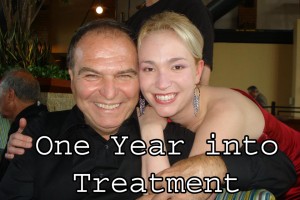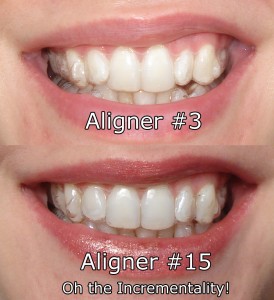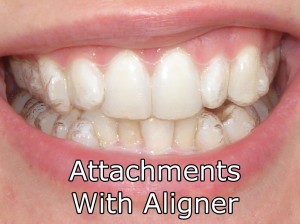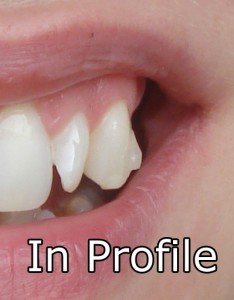 I’ve been functionally done with treatment for almost a year now now. All told, the actual treatment took about a year longer than the original projection… but that’s okay. The refinements stage is the easiest stage; after 40-some trays of initial treatment, 20-some trays of the first stage of refinements, the prospect of 15 more for a second round was no sweat. Refinement aligners are only worn for one week each — who cares if they get stained? That’s more often than I change my disposable contacts! Refinement trays also represent a smaller and more subtle tooth movement each time; any pain or discomfort is really negligible. By that point I was so accustomed to wearing the aligners, and very personally invested in getting the most out of my treatment — besides getting my $5K money’s worth, going through this process made me more interested in my teeth. I made the primarily-cosmetic decision to fix my teeth as an adult, and I became invested in the process. With all the initial worries of treatment behind me, continuing until my orthodontist said we had reached the end was a natural one.
I’ve been functionally done with treatment for almost a year now now. All told, the actual treatment took about a year longer than the original projection… but that’s okay. The refinements stage is the easiest stage; after 40-some trays of initial treatment, 20-some trays of the first stage of refinements, the prospect of 15 more for a second round was no sweat. Refinement aligners are only worn for one week each — who cares if they get stained? That’s more often than I change my disposable contacts! Refinement trays also represent a smaller and more subtle tooth movement each time; any pain or discomfort is really negligible. By that point I was so accustomed to wearing the aligners, and very personally invested in getting the most out of my treatment — besides getting my $5K money’s worth, going through this process made me more interested in my teeth. I made the primarily-cosmetic decision to fix my teeth as an adult, and I became invested in the process. With all the initial worries of treatment behind me, continuing until my orthodontist said we had reached the end was a natural one.
There was only one surprise along the way. Between Refinements #1 and Refinements #2, Invisalign switched to a new primary aligner material, Smarttrack. I did notice that the first aligner of my new refinement set seemed an easier fit when they first put it in at my orthodontist’s, but I didn’t suspect anything was truly different until about an hour later, strolling through our open market, the Strip District, when a rough spot suddenly appeared on my aligner over my center bottom teeth. Was my aligner cracked? Already? Cracked aligners had happened to me once or twice. No problem. With the refinements being so subtle, I would just pop the second aligner in early and wear it for two weeks, rather than one. By the time I got back home, a corresponding rough spot had emerged on the corresponding tooth on my top aligner. I switched to my second set… and two hours later, a rough spot emerged in exactly the same place. I compared aligner envelopes from last round, and sure enough, the new round said “Smarttrack” in the same place the old round said “EX30.”
 Suffice to say, I was a bit miffed. I left a message at my orthodontist’s office and did some online research. Other people had indeed experienced the same trouble with the Smarttrack aligners, but usually toward the end of their required time for wearing the aligners. When my orthodontist’s office got back to me, they explained that the Smarttrack material requires a “comfort liner” and that shredding is possible but rare. Indeed, upon closer look, I saw that the rough spots on my aligners were places where the thin liner had broken, as if a small hole had formed in a layer of Saran wrap and was peeling off.
Suffice to say, I was a bit miffed. I left a message at my orthodontist’s office and did some online research. Other people had indeed experienced the same trouble with the Smarttrack aligners, but usually toward the end of their required time for wearing the aligners. When my orthodontist’s office got back to me, they explained that the Smarttrack material requires a “comfort liner” and that shredding is possible but rare. Indeed, upon closer look, I saw that the rough spots on my aligners were places where the thin liner had broken, as if a small hole had formed in a layer of Saran wrap and was peeling off.
The problem, it appeared, was that the quite indestructible nature of the EX30 aligners had turned me into something of an “aligner grinder.” I don’t grind my teeth when the aligner, or now retainer, are out, but when they’re in, I gnaw away. My orthodontist gave my permanent retainer extra thickness to handle it and made it in-house out of a different material. This turn of events is perhaps not surprising. I have always been something of a mouth-fidgeter. One of the great things about having straight teeth now is that I used to worry at the crooks in my crowded bottom teeth with my tongue when I got stressed. Now there are no crooks to mess with. During the Invisalign process, this tendency must have converted to grinding.
All I can say is that I’m glad I didn’t get Smarttrack until the last stage of refinements. I don’t know if I could have made it through the original course of treatment wearing 42 aligners for two weeks each. With an iron will I did my best to retrain myself not to grind my teeth (I do it when awake and not while sleeping). It worked to a certain extent, but by the last day or two of each Smarttrack aligner, there was usually at least one small bloom of shredded plastic, though mostly on my molars which made it easier to ignore than on my front teeth. I did successfully stop grinding in the front of my mouth.
 To the credit of the Smarttrack, I can attest that they certainly are more comfortable. They are very elastic, and I can only imagine that makes them easier to wear during the first stages of treatment. I’m betting they virtually eliminate the problem of aligners being so tight at first it’s hard to pop them out. Being more elastic makes them, not only easier to get on and off, but better able to hold their shape. I could tell that my aligners were nudging my teeth more gradually into place throughout the entire week, rather than shoving them all at once into place on the first night, and then keeping them there for the rest of the wearing period. Also, in the interest of complete fairness, I have a friend who was also going through Invisalign at the time I was wearing the Smarttrack, and he didn’t seem bothered by the little bit of shredding he noticed — in fact, he hadn’t even noticed the change in material until I asked him about it.
To the credit of the Smarttrack, I can attest that they certainly are more comfortable. They are very elastic, and I can only imagine that makes them easier to wear during the first stages of treatment. I’m betting they virtually eliminate the problem of aligners being so tight at first it’s hard to pop them out. Being more elastic makes them, not only easier to get on and off, but better able to hold their shape. I could tell that my aligners were nudging my teeth more gradually into place throughout the entire week, rather than shoving them all at once into place on the first night, and then keeping them there for the rest of the wearing period. Also, in the interest of complete fairness, I have a friend who was also going through Invisalign at the time I was wearing the Smarttrack, and he didn’t seem bothered by the little bit of shredding he noticed — in fact, he hadn’t even noticed the change in material until I asked him about it.
All of these good qualities will give people who are worried about or sensitive to tooth pain a great advantage in using Invisalign. This treatment was already gentler than braces, but with the Smarttrack, I can’t imagine a kinder and softer way to move your teeth. Also, if the other claims of Smarttrack are to be believed, the process may even happen faster, since the new material moves teeth more efficiently and effectively.
Grinders beware. Where people who grind their teeth actually did better with the EX30 than their non-grinding counterparts… Smarttrack is a whole new ballgame. I’m not sure if they will even make a set of EX30, but if you grind your teeth, I would advise asking your orthodontist if the old aligner material is still available for your treatment.
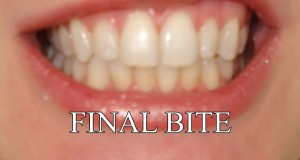 Otherwise, I’m settling well into post-aligner life. I got my permanent retainer in December 2013. It is indeed much thicker than the aligners. When I first put it in at the orthodontist’s office, it almost made me gag, but I’ve gotten used to it. In fact, I sometimes wear it out on errands in the morning or over the weekends. I couldn’t wear it to work — the way it effects my speech is more noticeable than the aligners, but not so noticeable that small transactions and interactions at stores would draw anyone’s attention. Despite the thickness of the retainer, my powerful grind was enough break my top tray after six months of wear. My orthodontist made me a new one at the time, but it looks like I will definitely be needing to replace my retainers on a regular basis as time goes on in order to continue good retention.
Otherwise, I’m settling well into post-aligner life. I got my permanent retainer in December 2013. It is indeed much thicker than the aligners. When I first put it in at the orthodontist’s office, it almost made me gag, but I’ve gotten used to it. In fact, I sometimes wear it out on errands in the morning or over the weekends. I couldn’t wear it to work — the way it effects my speech is more noticeable than the aligners, but not so noticeable that small transactions and interactions at stores would draw anyone’s attention. Despite the thickness of the retainer, my powerful grind was enough break my top tray after six months of wear. My orthodontist made me a new one at the time, but it looks like I will definitely be needing to replace my retainers on a regular basis as time goes on in order to continue good retention.
Overall, I’m very happy with the result of my treatment. My advice to anyone researching Invisalign is to go ahead and do it… with the caveat that you use an Elite Provider. My doctor in the Pittsburgh area is King Orthodontics. If you are a Pittsburgher, make them your first and last call. Anywhere else, go to an Elite provider, even if it involves a little inconvenience to get there. Experience and customer service make the biggest difference in this process. I am very glad I opted for Elite over even the Premier Preferred providers I looked into. Please, if you’re considering Invisalign, do the research, don’t go to a dentist, and don’t go to someone who specializes in metal braces. Elite providers specialize in Invisalign -go there!



